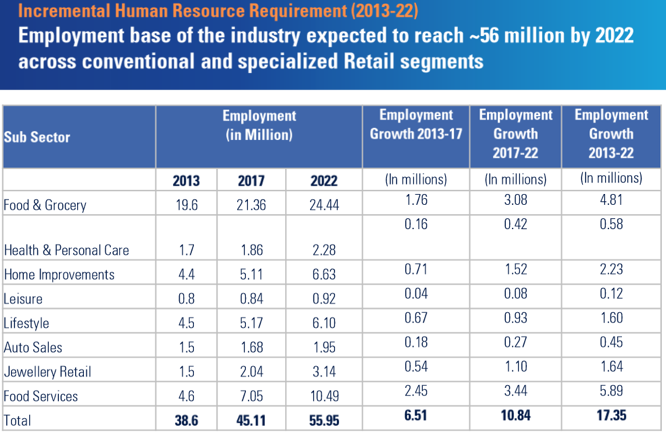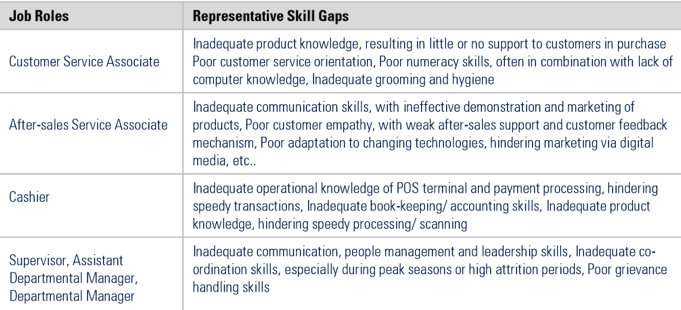Service Sector Calling – The Opportunities in The Challenges is our blog series to examine the in-demand skills needed by the next generation of workers in the service sector and to find out if there is an opportunity for VET and apprenticeships to fill the skill gap.
In Part I, we have picked Retail & E-commerce as our first sector analysis given its pivotal position in India’s service sector. In Part II we will look at vocational skills-based employment opportunities in Beauty & Wellness. In Part III, we will examine the potential of Tourism & Hospitality for job creation for the vocationally skilled. Our next sector analysis in Part IV will be Logistics.
Retails & E-commerce
India’s retail sector contributes to 23% of GDP1and is expected to reach $1 trillion by 2020 from $600 billion in 2015.2 Similarly, e-commerce sales are set to reach $100 billion in 2020 from $30 billion in 2016.2 Driving employment opportunities in retail is demand fuelled by a large consumption appetite from semi-urban and rural India. These hitherto largely underpenetrated markets experiencing rising disposable income represent the next wave of retail sector expansion in the country.
According to an NSDC-KPMG projection, India’s retail sector will need a workforce of around 56 million – with one of the highest incremental human capital requirement of 17.35 million till 2022.


The report further gives a breakdown of the specific skill sets required to meet demand.
Role-based skill gaps


If we look at policy enablers specific to retail, the government’s decision allowing 100% FDI in single-brand retail provides an opportunity to re-examine the retail sector in view of job creation and the required skills are this changing retail landscape. A surge of new jobs is expected especially in sales, warehousing, store operations, merchandising, customer service, shop floor executives, supply chain & logistics. IKEA’s ingress into Indian retail this year is a key example. In its flagship Hyderabad store direct hiring has been I,950 employees, 1,500 indirect employees with further plans of recruiting 15,000 employees over the next few years as it plans to set up 25 outlets in India by 2025.3 Although the exact breakdown of job roles are not known it is fair to assume that given the nature and scale of its business a lot of hiring will be for ‘hands-on’ skills. For instance,
it has already teamed up with UrbanClap to access a pool of 150 furniture assemblers as a value-added service to Indian customers. Another jobs angle is IKEA’s commendable non-negotiable commitment to have 50% of its workforce in India represented by women across all levels- including forklift drivers and assembling co-workers. Towards this, the retail giant has embarked on a skill-building programme to initially train 350 women from Telangana on retail-specific roles. The programme is envisaged to be rolled out across IKEA’s Indian outlets over the coming years.4
Additionally, to make an educated guess, the mandatory thirty percent local sourcing requirement on a foreign retail brand (after the initial five years settling in period) can have a multiplier effect in directly creating more jobs, for example, for skilled carpenters, tanners, cutters, seamsters, and indirectly creating additional demand in related sectors such as textile, leather, logistics etc.
Industry and analysts are hopeful that 100% FDI will spill over to multi-brand as well. If the same principle of mandatory local sourcing is also applied to multi-brand, it can create yet another massive opportunity for jobs. Some might argue that foreign investment in single or multi-brand retail is detrimental to medium to small neighborhood stores. However, if the wheels are set in the right places, we see this as a tremendous opportunity if retail brands start sourcing locally- from fresh produce to finished goods. Local stores can join as wholesale partners which will, in turn, require them to have skilled workers in warehousing, delivery, and logistics.
In similar lines, in 2016 the government announced 100% FDI in online marketplaces for the sale of e-commerce goods and services. This has been hailed as a major step in revving up the job creation potential in e-retail. Gurcharan Das, in a 2016 ToI blog5 noted, “ ….by 2020 the sector is expected to have 1.3 million sellers. Each seller (on an e-commerce site) creates four direct jobs and 12 indirect jobs in warehousing, delivery, and support services.” Thus we see the feeder effect of business and society friendly policy change.
Other notable policy enablers supporting rising consumerism of goods and services in retail; @_DigitalIndia is moving the country towards a cashless society (digital payments) which in turn will further augment online retail. The next generation of retail and e-commerce workers are being trained by @MSDESkillIndia . The introduction of GST as a single unified tax system is envisaged to make it easier for movement of goods and services which in turn will favour the retail business environment. As with any major economic opportunity, the Government has a key role to play, and these efforts one hopes will make a real difference.
Yet another area of exciting growth prospects for jobs in retail, owing to a surge in private equity funds is brick and mortar malls in India. Leading property consultants have estimated that nearly 85 new malls will spring up over the next five years with Tier II and III cities spurring demand. Property consultancy JLL has predicted around 20 million square feet of mall space will be joining the retail sector in the next three years.6 Significantly, this should bring about an influx of new jobs across the traditional retail space including in warehousing, inventory management, packaging, distribution, and logistics.
Quite clearly the demand is in place for the next wave of skilled workforce in retail. Our collective responsibility, as government and industry, is to ride the wave with enthusiasm and capitalize on this tremendous jobs creation opportunity
Stay tuned for subsequent posts in our series “Why the Service Sector matters for Vocational Training and Apprenticeships in India”, where we will be taking a closer look at the opportunities for vocational skills in Beauty & Wellness, Tourism and Hospitality, and Logistics. Sign up to our weekly newsletter to receive all the latest views, news, research and articles on apprenticeships. You can also register to contribute your opinion on the subject matter.













